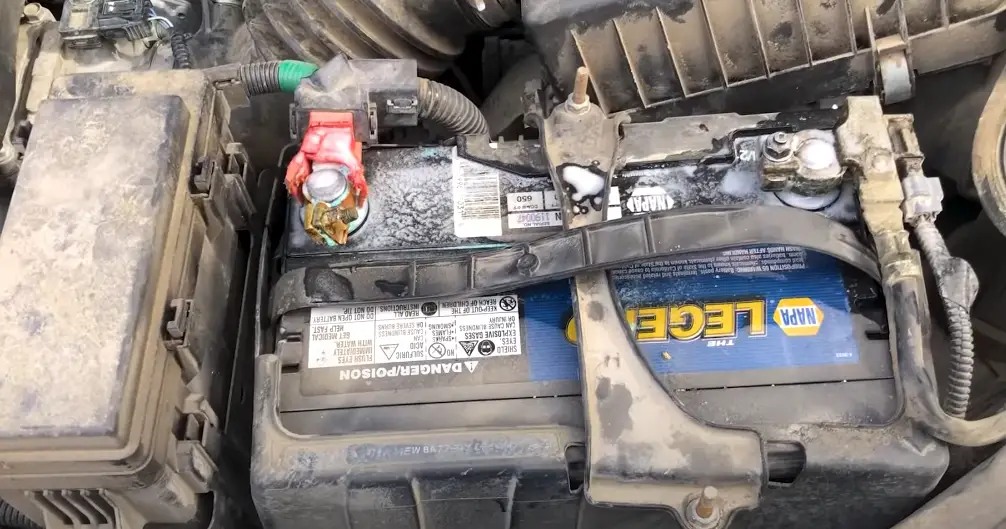To clean corroded battery terminals, mix baking soda and water, scrub terminals with a brush. Use a damp cloth to wipe clean.
Are you experiencing issues with your battery due to corroded terminals? It’s a common problem that can hinder your vehicle’s performance. Fortunately, there are simple and effective ways to address this issue. By following the right cleaning process, you can restore your battery terminals to optimal condition.
In this blog, we will explore the step-by-step guide to cleaning corroded battery terminals, ensuring your vehicle runs smoothly and efficiently. Let’s dive in and learn how to tackle this common automotive maintenance task effectively.

How to Clean Corroded Battery Terminals
Battery terminals can corrode over time due to exposure to the elements and the chemical reactions occurring within the battery. Corrosion on battery terminals can lead to poor electrical connections, causing your car to start slowly or not at all.
Cleaning corroded battery terminals is a relatively simple maintenance task that can improve your car’s performance and extend the life of your battery. This guide will walk you through the process step by step.
Battery Corrosion
Battery terminal corrosion is typically a buildup of white, ashy deposits on the terminals and cable ends. It can occur due to several reasons:
- Electrolyte Leakage: Over time, the battery’s acid can leak and cause corrosion around the terminals.
- Chemical Reaction: When the sulfuric acid in the battery reacts with the lead terminals, it produces lead sulfate, leading to corrosion.
- Overcharging: Excessive charging can cause the battery to heat up and release acidic fumes, which can corrode the terminals.

Credit: www.reddit.com
Materials Needed For Cleaning
To clean corroded battery terminals, you will need a few materials such as baking soda, water, a toothbrush, and safety gloves. Mix baking soda and water to form a paste, then apply it to the terminals and scrub with a toothbrush.
Finally, rinse with water and dry the terminals thoroughly.
When it comes to cleaning corroded battery terminals, you don’t need to be a mechanic or an expert. With the right materials, you can get the job done quickly and easily. In this post, we will discuss the materials needed for cleaning corroded battery terminals.
Common Household Items
Most of the materials needed for cleaning corroded battery terminals can be found in your home. Here are some common household items you’ll need:
- Baking soda
- Water
- Vinegar
- Cotton swabs
- Small brush
- Protective gloves
Specialized Cleaning Tools
If you want to take your cleaning to the next level, you can invest in some specialized cleaning tools. Here are some tools that can help you clean corroded battery terminals:
| Tool | Description |
|---|---|
| Battery terminal cleaner | A specialized tool designed to clean battery terminals and remove corrosion. |
| Battery terminal brush | A small brush designed to clean battery terminals and remove corrosion. |
| Battery post cleaner | A specialized tool designed to clean battery posts and remove corrosion. |
| Battery post brush | A small brush designed to clean battery posts and remove corrosion. |
With these materials at hand, you can easily clean corroded battery terminals. Remember to wear protective gloves when handling these materials to avoid direct contact with the battery acid.
Safety Precautions
Before you start, it’s essential to take the following safety precautions:
- Wear Protective Gear: Battery acid is corrosive and can cause burns or injury. Always wear gloves and safety goggles.
- Work in a Well-Ventilated Area: Battery fumes can be harmful if inhaled.
- Avoid Sparks: Ensure all electrical accessories are off, and do not smoke or create sparks near the battery.
Corroded Battery Terminals Cleaning Process
When cleaning corroded battery terminals, it’s essential to follow a systematic process to ensure effective results. Below are the steps involved:
-
Turn Off the Engine: Ensure your car is off and the keys are removed from the ignition.
-
Locate the Battery: Open the hood and find the battery. It’s usually a rectangular box with two cables connected to it.
-
Disconnect the Battery Terminals:
- Start with the negative terminal (marked with a “-” or black cable). Use a wrench or pliers to loosen the nut and remove the cable.
- Next, disconnect the positive terminal (marked with a “+” or red cable). Loosen the nut and remove the cable.
-
Inspect the Battery: Check for any cracks or leaks. If you find any, the battery may need to be replaced.
-
Prepare a Cleaning Solution: Mix a tablespoon of baking soda with a cup of water. The baking soda will neutralize the acidic corrosion.
-
Clean the Terminals:
- Dip a wire brush or battery terminal cleaner into the baking soda solution.
- Scrub the terminals and the inside of the cable clamps until the corrosion is removed.
- For stubborn corrosion, let the baking soda solution sit on the terminals for a few minutes before scrubbing.
-
Rinse and Dry: Use a clean cloth or paper towels to wipe off the baking soda solution. Ensure the terminals and cable ends are thoroughly dried.
-
Reconnect the Terminals:
- Start with the positive terminal. Attach the cable clamp to the terminal and tighten the nut.
- Next, reconnect the negative terminal and tighten the nut.
- Ensure the connections are secure but not overly tight to avoid damaging the terminals.
-
Apply Protective Coating: To prevent future corrosion, apply a thin layer of petroleum jelly or battery terminal protectant to the terminals and cable ends.
-
Close the Hood and Start the Car: Once everything is reconnected, close the hood and start your car to ensure it starts smoothly.
Tips for Preventing Future Corrosion
- Regular Maintenance: Check your battery terminals regularly for signs of corrosion and clean them as needed.
- Use Terminal Protectors: Battery terminal protectors or anti-corrosion washers can be placed over the terminals to prevent corrosion.
- Ensure Proper Charging: Avoid overcharging your battery by ensuring your alternator is functioning correctly.
- Secure the Battery: Ensure the battery is properly secured to minimize vibrations, which can cause leaks and corrosion.

Credit: www.youtube.com
Frequently Asked Questions
Here are some FAQs about battery terminal –
How Do I Know If My Battery Terminals Are Corroded?
Inspect the terminals for a powdery, bluish-white substance. This indicates corrosion and requires cleaning.
What Causes Battery Terminals To Corrode?
Corrosion occurs due to exposure to moisture, battery acid leaks, and oxidation of the metal.
Can I Clean Corroded Battery Terminals With Household Items?
Yes, a mixture of baking soda and water can effectively clean corroded battery terminals.
How Often Should I Clean My Battery Terminals?
Clean your battery terminals every 6 months to maintain optimal performance and prevent corrosion.
What Can Happen If I Don’t Clean Corroded Battery Terminals?
Uncleaned terminals can lead to poor electrical connections, difficulty starting the car, and potential damage to the battery.
Conclusion
Cleaning corroded battery terminals is a simple yet important task to ensure the optimal performance of your batteries. By following the steps outlined in this blog post, you can effectively remove corrosion and extend the lifespan of your batteries. Regular maintenance and cleaning will not only prevent potential damage to your devices but also save you money in the long run.
Take the time to clean your battery terminals regularly and enjoy reliable and efficient battery power.